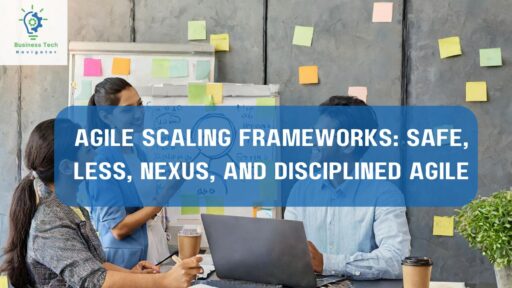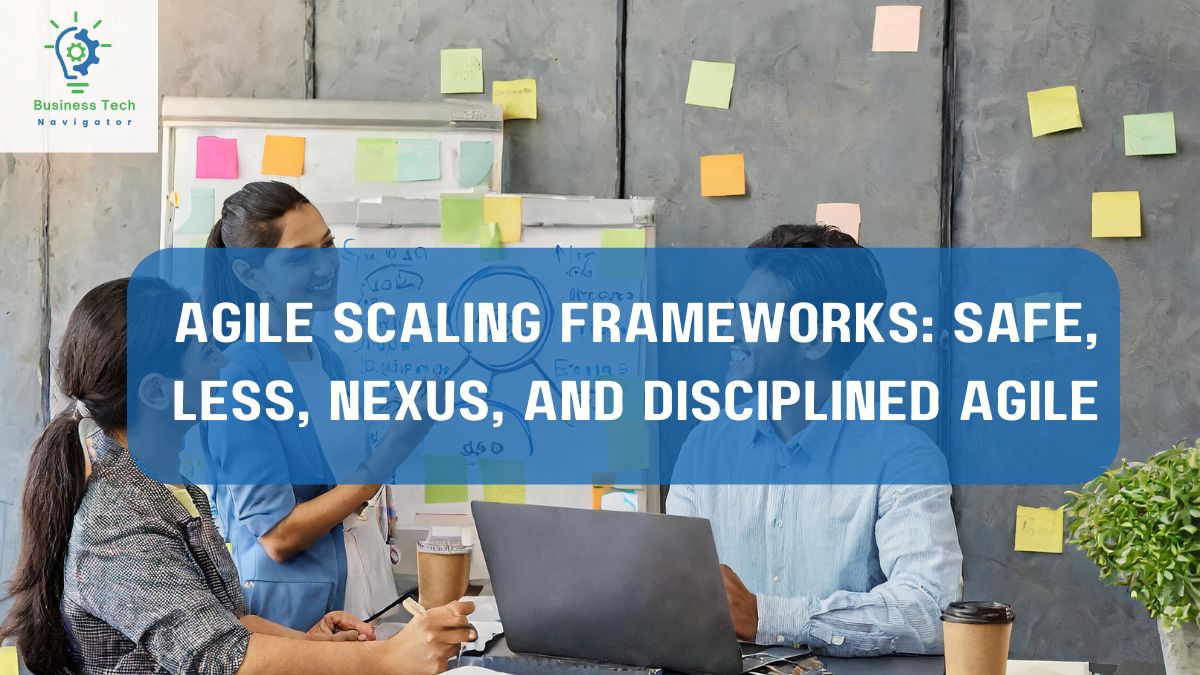In the fast-paced world of software development and project management, the principles of Agile have proven to be a game-changer for many organizations. However, as demand grows for Agile methodologies that go beyond the confines of small, single-team projects, a new need has arisen — the scaling of Agile. This is not a one-size-fits-all approach; it’s a strategic choice that can dictate the success of enterprise-level Agile transformations.
Organizations grappling with the complexities of scaling Agile face a myriad of challenges and an array of potential solutions. They’re not just choosing to scale Agile; they’re choosing which Agile scaling framework is best suited to their unique environment. This blog post is a comprehensive guide for Agile practitioners, project managers, and C-suite professionals navigating these choices.

The Importance of Choosing the Right Agile Scaling Framework
Selecting an Agile scaling framework can be as impactful as choosing the first Agile framework. The right framework should foster a culture of agility, support effective team collaboration, and guide the organization towards leaner practices that amplify business value. Conversely, choosing the wrong framework can stifle growth, create discord, and ultimately fail to deliver the expected benefits of Agile at scale.
How to Navigate the Sea of Frameworks
With the abundance of Agile scaling frameworks available, understanding the nuances of each is essential. Four of the most prominent ones — Scaled Agile Framework (SAFe), Large-Scale Scrum (LeSS), Disciplined Agile (DA), and Nexus — offer distinct approaches to scaling Agile. By unraveling the strengths, weaknesses, and unique characteristics of these frameworks, enterprises can make well-informed decisions.
Factors for Successful Agile Framework Selection
Determining the most suitable Agile scaling framework for an organization requires a structured analysis. While there are many influencing factors, key considerations center on organizational size, structure, and culture, as well as the technical landscape, distribution levels, and perceived value of incorporating Agile methodologies.
Size Does Matter
The scale of an organization plays a significant role in framework selection. Large, medium, and small-sized companies have vastly different needs when it comes to scaling Agile.
Structure and Governance
Organizational structure and governance models must align closely with any chosen Agile scaling framework to avoid resistance and ensure successful adoption.
Examining Culture and Discipline
Cultural fit is no less important than the framework’s technical elements. An iterative, collaborative, and transparent culture is imperative for success.
The Technical Landscape
The complexity of an organization’s technical environment can either support or undermine the chosen framework’s effectiveness.
Geographical Distribution
The degree of distribution within an organization will affect how it scales Agile. Frameworks vary in how they address the coordination and communication challenges of distributed teams.
Perceived Business Value
Corporate leadership and the broader organization must perceive the value of Agile scaling to motivate adoption and sustain transformation efforts.
Scrum of Scrums: The Foundation of Agile Scaling
Before taking a deep dive into specific scaling frameworks, it’s crucial to understand the essentials of scaling Agile. The Scrum of Scrums (SoS) is a powerful collaboration technique used to coordinate work among multiple teams working on complex products or solutions.
Unveiling the Core Principles and Values
Simplicity, focus, openness, and respect are the cornerstones of effective Scrum of Scrums, amplifying the principles of Agile for multiple teams.
Key Components and Roles
The anchor of Scrum of Scrums lies in its meetings, deliverables, and representatives from each team who serve as communication focal points.
Implementation Challenges and Benefits
Although structured to enhance inter-team collaboration, scaling Scrum with Scrum of Scrums is not without its share of challenges, which are often outweighed by substantial benefits.
Real-World Examples of Various Scrum Scaling Structures
Different organizations have implemented various forms of Scrum scaling structures. It’s valuable to examine both their successes and the hurdles they’ve encountered.

The Scaled Agile Framework (SAFe) in Depth
SAFe is one of the most popular Agile scaling frameworks, known for providing a complete methodology for large organizations to scale Agile principles at the team, program, and portfolio levels.
Unpacking SAFe’s Core Principles and Values
SAFe is built on tenets that promote alignment, transparency, program execution, and lean-agile thinking at scale.
Key Components and Roles in the SAFe Universe
The SAFe Big Picture features a multitude of roles, events, and artifacts that bring structure to Agile delivery on a grand scale.
Implementing SAFe: A Stepwise Approach
SAFe’s scaled implementation roadmap focuses on a continuous delivery pipeline, DevOps, and Release on Demand — critical for business agility.
Real-World SAFe Adoption Scenarios
Organizations across the globe have embraced SAFe, including industry leaders in software, finance, and manufacturing, realizing both process and cultural enhancements.
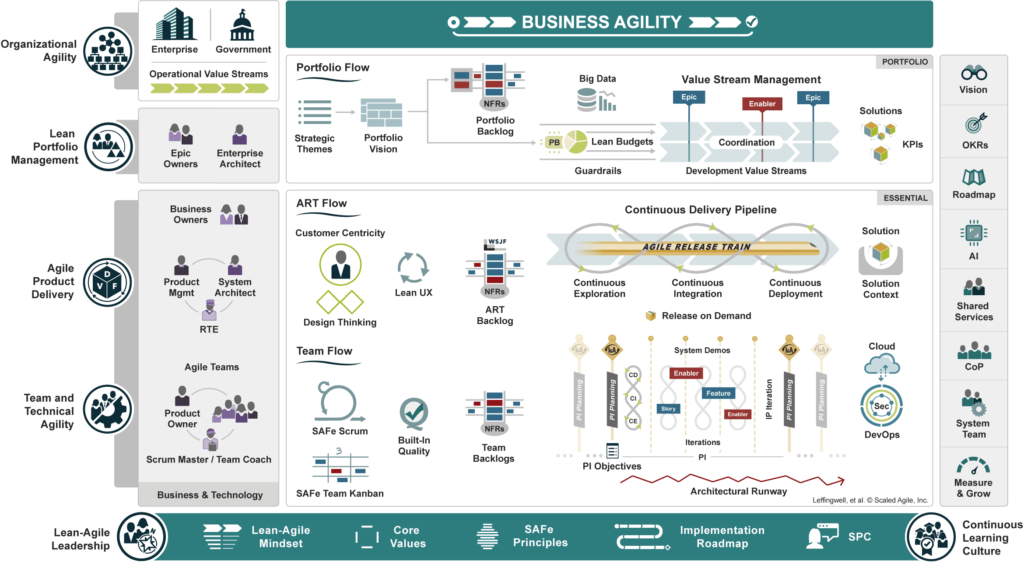
Large-Scale Scrum (LeSS) in Practice
LeSS is an extensive framework for scaling agile development, enabling multiple teams to work on one product. It focuses on simplifying organizational structure and reducing complexity to more effectively coordinate large undertakings.
Understanding the Basics of LeSS
LeSS abides by the Scrum principles of empirical process control, self-management, and a focus on delivering value through increments.
The Pillars of LeSS
LeSS’s three pillars — applying Scrum with a single product owner, a feature team structure, and a definition of a “complete” product — are key to its success.
Comparing LeSS with Traditional Scrum
LeSS is often seen as a natural evolution of the classic Scrum method, introducing adjustments to deal with the challenges of larger projects.
The Power of LeSS in Agile Transformations
LeSS is particularly impactful when used to transform large, traditional undertakings into leaner, more agile workflows.
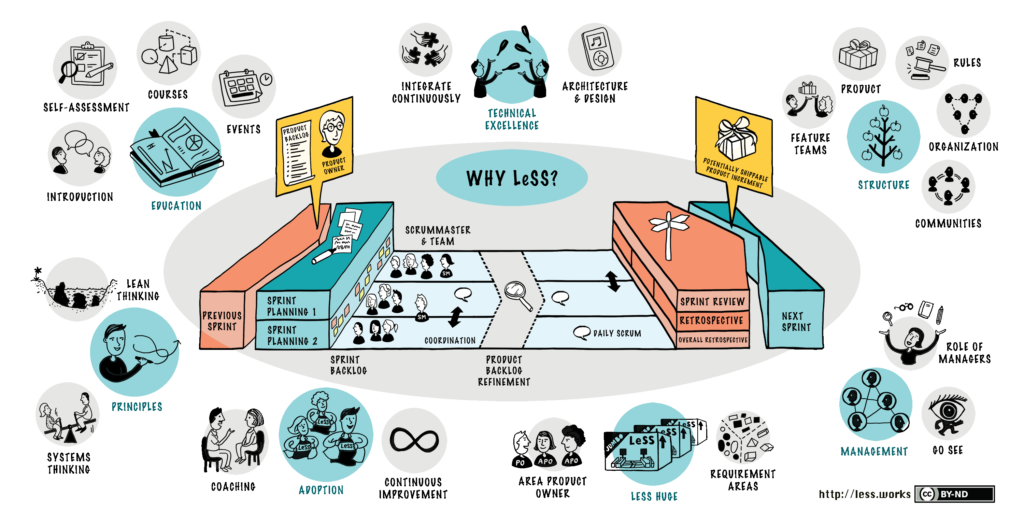
The Nexus Framework for Collaboration
Developed by Ken Schwaber, co-creator of Scrum, Nexus is an Agile framework that focuses on the cohesion of multiple Scrum teams in complex product development.
The Core of Nexus Framework
At Nexus’s heart are scaled Scrum events and new “scrum-of-scrum” events that serve as a forcing function for cross-team collaboration.
Roles and Responsibilities
Nexus clarifies the roles and responsibilities of those involved, ensuring every team member knows their part in the integrated whole.
Examining Nexus’s Benefits and Challenges
Nexus is highly efficient for managing dependencies and ensuring integration, but may require significant organizational changes to implement effectively.
Real-World Cases of Successful Nexus Implementations
Organizations have found success in diverse industries when using Nexus to align multiple teams toward common product goals.
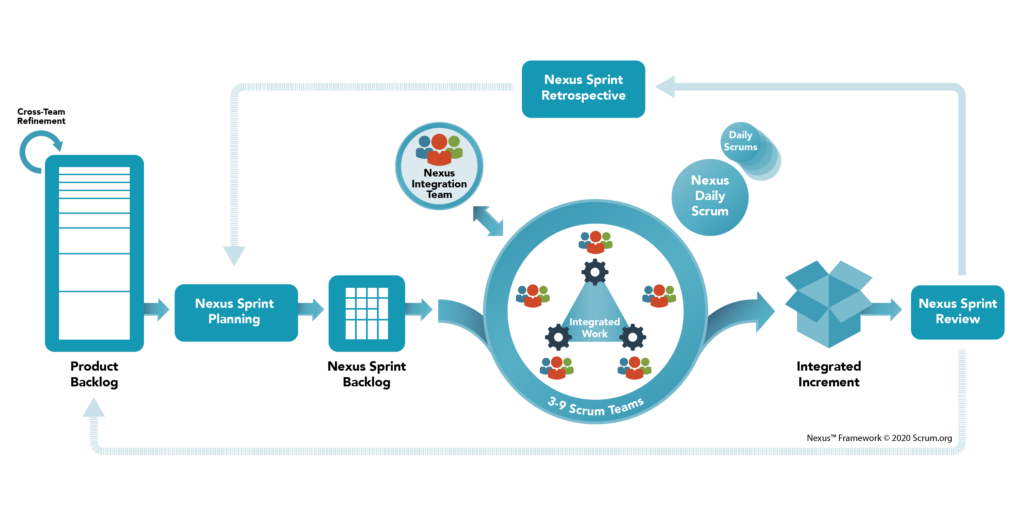
Disciplined Agile (DA): Agile for a New Decade
The Disciplined Agile framework, inspired by Agile Manifesto co-author Scott Ambler, provides a tool kit that takes a people-first, learning-oriented approach to software development.
An Overview of DA
DA is a hybrid framework that focuses on roles and workflow processes, offering practitioners numerous tools and strategies for successful Agile transformations.

The Disciplined Agile Delivery (DAD) Framework
Grounded in lean and flow discussions, DAD encompasses Inception, Construction, and Transition phases, aligning closely with Agile principles.

Tailoring DA to Your Organizational Needs
One of DA’s most compelling features is its adaptability to unique organizational contexts, reducing resistance and improving buy-in.
Real-World Applications of DA
The flexibility of the DA framework has been underscored in successful implementations across a wide range of industries.
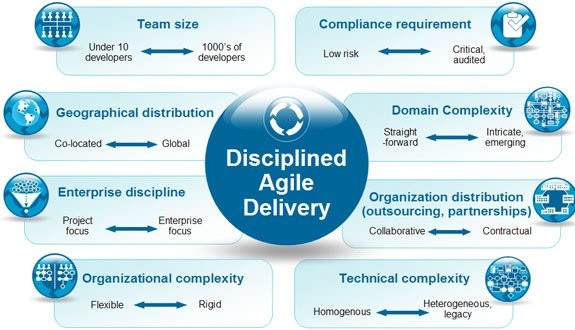
Strengths and Weaknesses of Agile Scaling Frameworks
No framework is perfect, and each has its share of strengths and deficiencies. Recognizing these is key to selecting the most effective approach for your organization.
A Closer Look at SAFe, LeSS, Nexus, and DA
Each of the four frameworks is designed to handle unique scaling challenges. It’s important to understand how they measure up in real-world settings.
Identifying Scenarios Where Each Framework Excels
While no single framework is universally superior, specific scenarios can heavily favor one over others, depending on the nature of the project or product involved.
Trade-Offs and Considerations
Considerations such as the time required for learning and transition, costs associated with framework adoption, and the depth of change required within the organization must be weighed against the benefits each framework offers.
Comparative Analysis of Agile Scaling Frameworks
Comparing SAFe, LeSS, Nexus, and DA side by side provides a comprehensive look at how each one handles the challenges of enterprise-scale Agile transformation.
Scalability: How Do They Scale?
Each framework tackles scaling Agile in its unique way, dictated by the principles it’s built upon.
Flexibility: Adapting to Organizational Cultures
Some frameworks allow for more flexibility than others, enabling a better fit with diverse organizational cultures.
Ensuring True Alignment with Agile Values
While all frameworks claim to adhere to core Agile principles, their execution often differs. It’s crucial to ensure that the chosen framework’s values align with the broader Agile manifesto.
A Glimpse into the Challenges and Limitations
Recognizing the limits of each framework provides a more realistic understanding of what to expect during a scaling process.

Selecting the Right Agile Scaling Framework
Navigating the world of Agile scaling frameworks is as much an art as a science. Knowing what to look for and taking a methodical, data-driven approach to selection is key.
The Critical Factors for Choosing a Framework
Certain factors must be assessed when choosing an Agile scaling framework. These include organizational readiness, cultural fit, and the specific requirements of the business.
Assessing Organizational Readiness and Maturity
An honest evaluation of the organization’s current state is essential. This readiness should be a determining factor in any framework selection.
Tailoring Frameworks to Meet Specific Needs
Adopting an Agile scaling framework is rarely a plug-and-play affair. The ability to tailor and customize a chosen framework to the specific organizational context is vital for long-term success.
Recommendations for Different Organizational Contexts
Based on the overarching size, structure, and culture of an organization, certain Agile frameworks may be more recommendable than others.
Conclusion
The decision to scale Agile is a significant one, carrying with it the potential for vast rewards in efficiency, productivity, and customer satisfaction. However, the path to Agile at scale is not without its challenges, and choosing the right Agile scaling framework is a critical first step. By understanding the unique merits and areas of applicability of the prominent frameworks — SAFe, LeSS, Nexus, and Disciplined Agile — organizations can pave the way for a successful enterprise-level Agile transformation.
In summary, Agile scaling framework selection is an iterative and thoughtful process. It requires deep consideration of organizational needs, an understanding of the available frameworks, and a commitment to aligning values with action. By following the guidance in this post, enterprises can make more informed choices and chart a path to sustained agility and business success.


